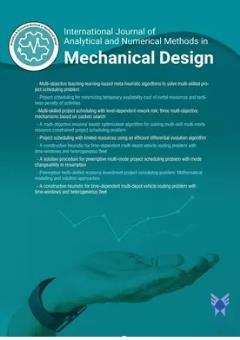Comparative Study of Low-Velocity Impact on Carbon Fiber and Glass Fiber Composite Cylinders
Subject Areas : Analytical and Numerical Methods in Mechanical DesignSimin Dokht Rayat 1 , M.Fazel Hajikarimi 2 , Ali Rahmati 3 , Hamed Ghasemi 4
1 -
2 -
3 -
4 -
Keywords: Low-velocity impact, Carbon fiber reinforced polymer (CFRP), Glass fiber reinforced polymer (GFRP), Hybrid composites, Composite cylinder, Analytical modeling, Energy absorption,
Abstract :
This paper presents an analytical and numerical study of low-velocity impact response in composite cylinders made of carbon fiber, glass fiber, and hybrid layups. A triangular approximation was used to model the analytical force–time history [1,2], while finite element (FE) simulations were performed using Abaqus/Explicit [7,19]. Four configurations were analyzed: carbon-only, glass-only, carbon-outside/glass-inside, and glass-outside/carbon-inside. The analytical model derives closedform expressions for impulse, contact duration, displacement, and stiffness [3,5]. Results show that CFRP cylinders exhibit higher peak forces and shorter contact durations, while GFRP cylinders undergo larger displacements and absorb more energy through deformation [4,6,23]. Hybrid specimens display intermediate responses, with stacking sequence strongly influencing the outcome [8,9,13].
Fiber-reinforced composites are widely used in aerospace, automotive, marine, and energy applications due to their high strength-to-weight ratio [16]. Among these, CFRP are valued for their high stiffness but are relatively brittle and costly [1,2]. GFRP, in contrast, are cheaper and tougher but less stiff [3,4].
Cylindrical structures such as pipelines, pressure vessels, and shells are often exposed to accidental low-velocity impacts [23,24]. Understanding the comparative performance of CFRP, GFRP, and hybrids is essential for safe and optimized design. While several studies explored impact response of plates [10,12,14], fewer works addressed cylindrical shells. The present study combines analytical and numerical approaches to compare CFRP, GFRP, and hybrid cylinders.
[1] Abrate, S. Impact on Composite Structures. Cambridge
University Press, 1998.
[2] Cantwell, W. J., & Morton, J. The impact resistance of
composite materials—a review. Composites, 22(5), 347–
362, 1991. https://doi.org/10.1016/0010-4361(91)90549-V
[3] Saraswat, M. K., Kumar, D., & Choudhary, A.
Comparative analysis of low-velocity impact on glass and
carbon fiber reinforced polymer laminates. Journal of
Composite Materials, 51(2), 189–202, 2017.
https://doi.org/10.1177/0021998316631852
[4] Kumar, S., Singh, H., & Chauhan, A. Hybrid
composites of carbon and glass fiber under impact loading:
An experimental study. Materials Today: Proceedings, 18,
1137–1145, 2019.
https://doi.org/10.1016/j.matpr.2019.06.514
[5] Li, N., Hu, N., & Fukunaga, H. Low-velocity impact
response of composite laminates subjected to transverse
impact. Composites Part A: Applied Science and
Manufacturing, 33(8), 1055–1062, 2002.
https://doi.org/10.1016/S1359-835X(02)00025-9
[6] Zhang, X., & Yang, Y. Damage mechanisms and failure
modes in composite laminates under low-velocity impact.4
Composite Structures, 138, 240–250, 2016.
https://doi.org/10.1016/j.compstruct.2015.11.045
[7] Heimbs, S. Virtual testing of sandwich core structures
using dynamic finite element simulations. Composite
Structures, 93(9), 2249–2261, 2011.
https://doi.org/10.1016/j.compstruct.2010.12.007
[8] Hosur, M. V., Abdullah, M., & Jeelani, S. Studies on
the low-velocity impact response of woven hybrid
composites. Composite Structures, 67(3), 253–262, 2005.
https://doi.org/10.1016/S0263-8223(04)00120-5
[9] Wu, G., Ma, L., & Liu, W. Low-velocity impact and
compression-after-impact behavior of carbon/glass hybrid
composites. Materials Science and Engineering A, 478(1–
2), 292–298, 2007.
https://doi.org/10.1016/j.msea.2007.05.066
[10] Sun, C. T., & Chen, J. L. A simple flow rule for
characterizing nonlinear behavior of fiber composites.
Journal of Composite Materials, 19(5), 490–501, 1985.
https://doi.org/10.1177/002199838501900505
[11] [3] J. Rivera, P. Kumar, "Hybrid analytical-FE models
for low-velocity impact in fiber-reinforced
composites," Composite Part A: Applied Science and
Manufacturing, 2022.
[12] Liu, D., & Malvern, L. E. Matrix cracking in impacted
glass/epoxy plates. Journal of Composite Materials, 21(7),
594–609, 1987.
https://doi.org/10.1177/002199838702100703
[13] Amaro, A. M., Reis, P. N. B., Neto, M. A., & Louro,
C. Effects of different configurations on mechanical
behavior of hybrid composites. Composites Part B:
Engineering, 52, 217–223, 2013.
https://doi.org/10.1016/j.compositesb.2013.04.033
[14] L. Zhang, Y. Li, H. Chen, "Impact resistance of
GFRP tubes under axial loading: Experimental and
numerical study," Engineering Fracture Mechanics, 2020
[15] Abrate, S. Impact Engineering of Composite
Structures. Springer, 2016.
[16] Soutis, C. Fibre reinforced composites in aircraft
construction. Progress in Aerospace Sciences, 41(2), 143–
151, 2005. https://doi.org/10.1016/j.paerosci.2005.02.004
[17] Liu, H., Zhou, H., & Yang, J. Low-velocity impact and
damage characteristics of hybrid carbon/glass fiber
composites. Polymers & Polymer Composites, 26(7), 432–
441, 2018. https://doi.org/10.1177/0967391118787742
[18] Taraghi, I., Shokrieh, M. M., & Coyle, T. W. Lowvelocity impact response of woven hybrid composites
reinforced with carbon and glass fibers. Materials &
Design, 53, 1005–1013, 2014.
https://doi.org/10.1016/j.matdes.2013.07.059
[19] González, E. V., Maimí, P., Camanho, P. P., &
Mayugo, J. A. Simulation of drop-weight impact and
compression after impact tests on composite laminates.
Composite Structures, 94(11), 3364–3378, 2012.
https://doi.org/10.1016/j.compstruct.2012.05.003
[20] Mitra, N., & Baral, N. Comparative low-velocity
impact performance of hybrid composite laminates.
Applied Composite Materials, 22(2), 133–149, 2015.
https://doi.org/10.1007/s10443-014-9407-4
[21] Aktas, M., & Karakuzu, R. An experimental
investigation on repeated impact response of composite
plates. Composite Structures, 92(3), 571–579, 2010.
https://doi.org/10.1016/j.compstruct.2009.09.021
[22] Richardson, M. O. W., & Wisheart, M. J. Review of
low-velocity impact properties of composite materials.
Composites Part A: Applied Science and Manufacturing,
27(12), 1123–1131, 1996. https://doi.org/10.1016/1359-
835X(96)00074-7
[23] R. Gupta, S. Malhotra, "A review on manufacturing
and mechanical properties of CFRP and GFRP composites
post-2020," Materials Today Communications, 2023
[24] Pandya, K. S., Veerraju, C., & Naik, N. K. Hybrid
composites made of carbon and glass woven fabrics under
quasi-static loading. Materials & Design, 32(7), 4094–
4099, 2011. https://doi.org/10.1016/j.matdes.2011.03.018
[25] A. D. Mohed, S. R. K. S. S. De, "Low-velocity impact
response of CFRP laminates with different stacking
sequences under quasi-static loading," Composite
Structures, 2021
[26] S. Ahmed, M. Rahman, "Contact modeling in
composite shells under impact: A comparative
study," Vehicles, 2021
[27] S. Rayat, M Hajikarimi , H Ghasemi, A Rahmati,
“Using Experimental Observation and Numerical Analysis
for Examining the Responses of Carbon and’Kevlar Fibers
in Cylindrical Composites Exposed to Low-Velocity
Impact, 2025


